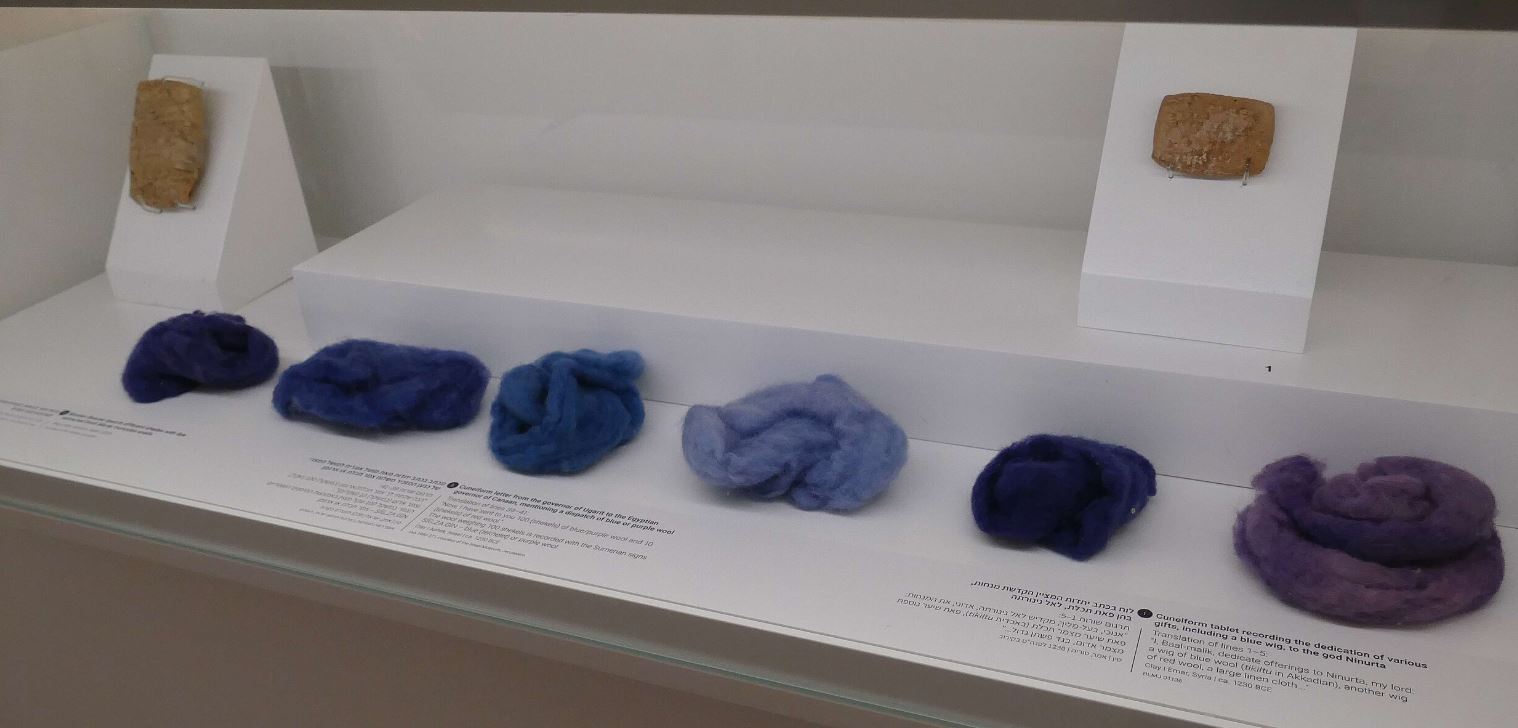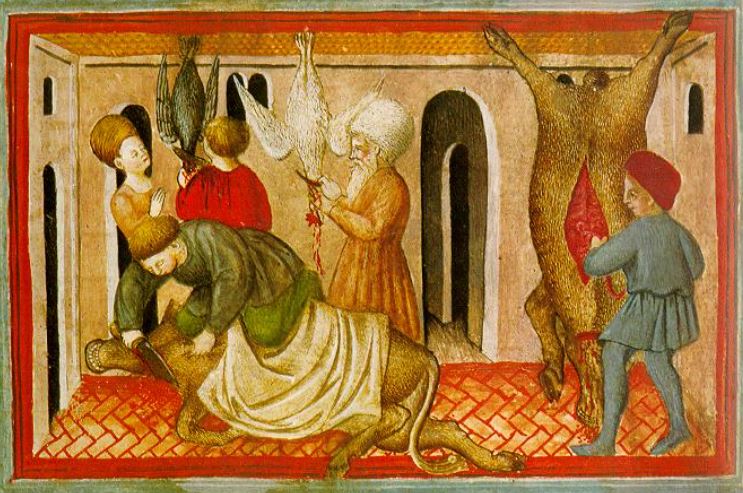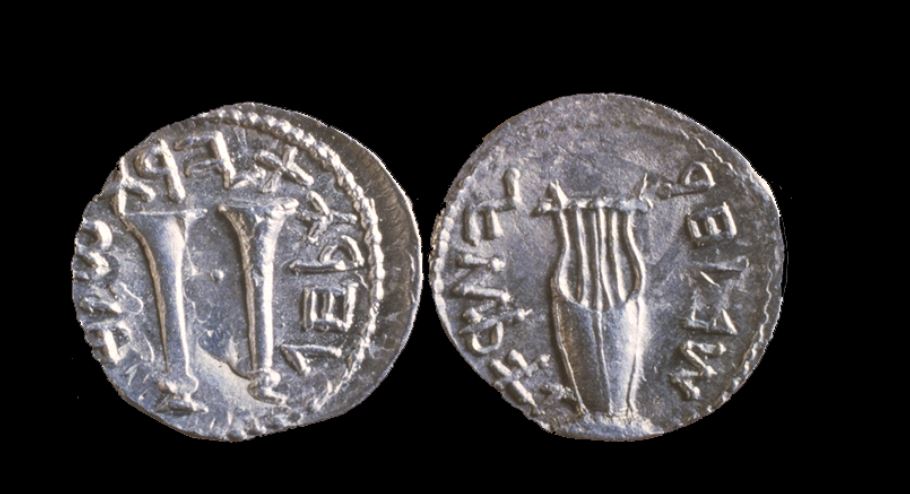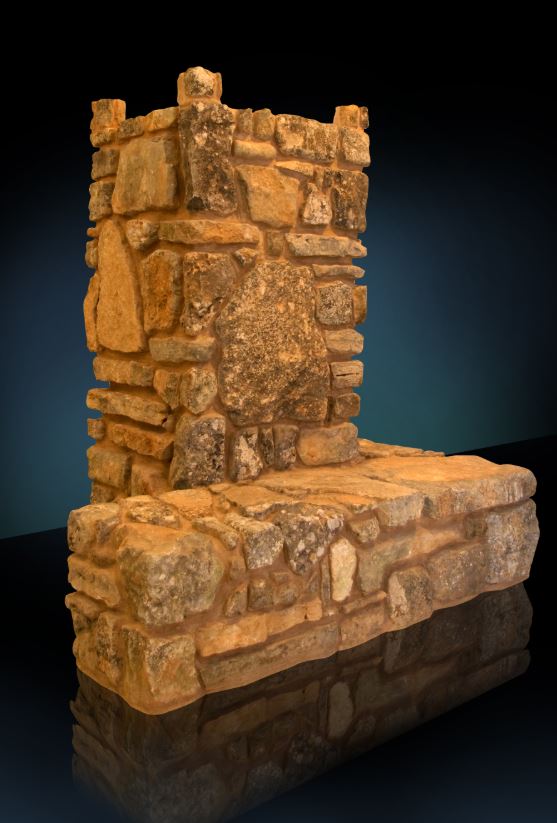When we picture ancient times, our image does not usually include exotic travel. We assume that people stayed close to home, living a traditional life in the same places that their ancestors did for centuries. This may have been true of the majority, but for certain extraordinary individuals, travel was part of their job description. Generals, caesars, and . .. rabbis (See here). Rabbi Akiva, in his desire to teach as many Jewish populations as possible, arrived in far flung places, all over Israel and in the Diaspora as well. We find him in Rome and here in Avodah Zarah, he travels to a place called Ginzak, where he is asked some difficult questions:
“Rabbi Akiva happened to come to Ginzak, whose residents asked him three questions” [to which he did not know the answer] (Avodah Zarah 34a)
Rabbi Akiva clearly made an impression in Ginzak, or perhaps visited more than once, since we also have an aggadic story of his that takes place there:
“Rabbi Akiva delivered a homily in Ginzak regarding the generation of the Flood, and they did not weep, but when he mentioned to them the story of Job, they immediately wept. He applied this verse to them [to the generation of the Flood]: “The womb will forget him; he will be sweet for the maggots; he will no longer be remembered, and injustice will be broken like a tree” (Job 24:20). “The womb [reḥem] will forget him” – they [the generation of the flood] caused mercy [raḥamim] to be forgotten among mankind; the Holy One blessed be He, too, caused His mercy to be forgotten from them.” (Bereshit Rabba 33:5)
Where is Ginzak? The rabbis connect it to the place that the ten tribes were exiled to in the Assyrian conquest in 720 BCE:
“Rabbi Abba bar Kahana says: What is the meaning of that which is written: “And he put them in Halah, and in Habor, on the river of Gozan, and in the cities of the Medes” (II Kings 18:11)? Halah is Ḥillazon; Habor is Hadyav; the river of Gozan is Ginzak” (Kiddushin 72a)
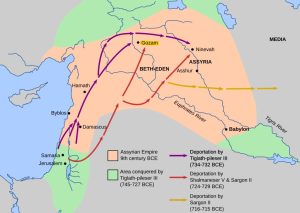
Joelholdsworth, CC BY-SA 3.0 <http://creativecommons.org/licenses/by-sa/3.0/>, via Wikimedia Commons
An Assyrian method of war was to transfer populations from their homeland to another conquered place, thus gaining a workforce that was not attached to their location and would not rebel. The area of Samaria was populated by people who would become known as the “Lion Converts” or the Samaritans (see here). Meanwhile, the ten tribes were brought to these faraway lands listed above.
As time passed, the location of the tribes became more mystical and mythical. They were lost behind the mountains of darkness, kept captive by the wild river Sambatyon, which Ramban identifies with Gozan:
“The meaning thereof is that I will put them in such a place and in such a manner that it will also be said of them “Where are they?” signifying that there will be no name or remnant left of them among the nations, and their place will not be known where they are. He thus alludes to the exile of the ten tribes that were banished to the river Gozan, this being the river which the Sages call Sabbatyon.” (Ramban Devarim 32:26)
But before they entered the realm of legend, these sites were real, identifiable places. Ginzak, or Ganzak, is a place in what is today Iran, close to its borders with Turkey and Iraq, south of Lake Urmia. At one point it was perhaps the capital of a powerful Persian kingdom that was eventually defeated by the Sassanians. It was also a major Zoroastrian center with one of the significant fire temples of that religion. A seventh century BCE document was discovered there that mentions a (presumably Jewish) captive named Dina and attempts to free her, perhaps one of the women of the ten tribes.
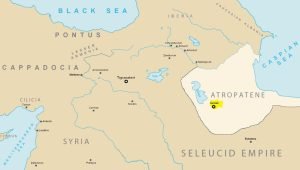
Aivazovsky, heavily edited by HistoryofIran, CC BY-SA 1.0 <https://creativecommons.org/licenses/by-sa/1.0>, via Wikimedia Commons
The city of Ginzak retained a Jewish population, as Rabbi Akiva’s visit shows. The Gemara is not pleased about the lineage of these Jews, as we see in Kiddushin, but they were Jewish enough to merit a visit from a Sage. Ginzak was a wealthy city since the Persian word for treasury is ginzach, a word that has entered Tanakh:
“אִם־עַל־הַמֶּ֣לֶךְ ט֔וֹב יִכָּתֵ֖ב לְאַבְּדָ֑ם וַעֲשֶׂ֨רֶת אֲלָפִ֜ים כִּכַּר־כֶּ֗סֶף אֶשְׁקוֹל֙ עַל־יְדֵי֙ עֹשֵׂ֣י הַמְּלָאכָ֔ה לְהָבִ֖יא אֶל־גִּנְזֵ֥י הַמֶּֽלֶךְ׃”
“If it please Your Majesty, let an edict be drawn for their destruction, and I will pay ten thousand talents of silver to the stewards for deposit in the royal treasury.” (Esther 3:9)
“וַיִּתֵּ֣ן דָּוִ֣יד לִשְׁלֹמֹ֣ה בְנ֡וֹ אֶת־תַּבְנִ֣ית הָאוּלָם֩ וְֽאֶת־בָּ֨תָּ֜יו וְגַנְזַכָּ֧יו וַעֲלִיֹּתָ֛יו וַחֲדָרָ֥יו הַפְּנִימִ֖ים וּבֵ֥ית הַכַּפֹּֽרֶת׃”
“David gave his son Solomon the plan of the porch and its houses, its storerooms and its upper chambers and inner chambers; and of the place of the Ark-cover;” (Divrei HaYamim 1 28:11)
The word ginzach has since evolved in interesting ways. A genizah is a place where you keep your worn out but still holy texts; the most famous one is the Cairo Genizah but genizot exist all over the Jewish world. The Mishnah mentions them in Masechet Shabbat:
“כָּל כִּתְבֵי הַקֹּדֶשׁ מַצִּילִין אוֹתָן מִפְּנֵי הַדְּלֵקָה, בֵּין שֶׁקּוֹרִין בָּהֶן וּבֵין שֶׁאֵין קוֹרִין בָּהֶן. וְאַף עַל פִּי שֶׁכְּתוּבִים בְּכָל לָשׁוֹן, טְעוּנִים גְּנִיזָה“
“all sacred writings, one may rescue them from the fire on Shabbat, whether they are read even though they were written in any foreign language. they require genizah.” (Mishnah Shabbat 16:1)
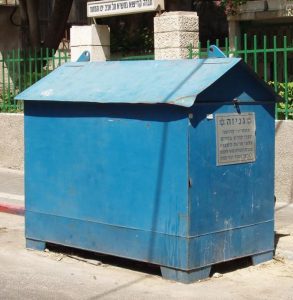
דוד שי at Hebrew Wikipedia, CC BY-SA 3.0 <https://creativecommons.org/licenses/by-sa/3.0>, via Wikimedia Commons
The verb לגנוז is also used by the rabbis to mean to hide away a treasure, as in this example:
“אָמַר לָהֶם: חֶמְדָּה טוֹבָה יֵשׁ לוֹ בְּבֵית גְּנָזָיו, שֶׁהָיְתָה גְּנוּזָה אֶצְלוֹ תְּשַׁע מֵאוֹת שִׁבְעִים וְאַרְבָּעָה דּוֹרוֹת קוֹדֶם שֶׁנִּבְרָא הָעוֹלָם; וּבִיקֵּשׁ לִיתְּנָהּ לְבָנָיו”
“He has a good and precious item in His treasury, that was hidden away with Him for 974 generations before the world was created, and He seeks to give it to his children” (Zevachim 116a)
From a treasury to a storehouse to a repository, the word ginzach eventually came to mean an archive. The State of Israel’s official archive was called till relatively recently Ginzach haMedinah, that term has since become outmoded and it is now called Archion haMedinah. But ginzach is not finished with us yet. The word for treasurer comes from it: a gizbar. And the Academy for Hebrew Language has recently added a Hebrew word for censorship, ginzarut.
Treasure your Hebrew words, even if they come from Persian!




